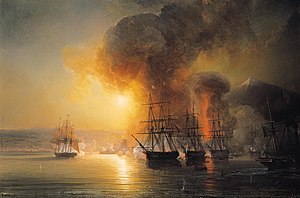Battle of Veracruz (1838)
| Battle of Veracruz | |||||||
|---|---|---|---|---|---|---|---|
| Part of the Pastry War | |||||||
 Bombardment of San Juan de Ulúa off Vera Cruz. From left to right, the corvette Créole, and the frigates Gloire, Néréide and Iphigénie. Painting by Théodore Gudin. |
|||||||
|
|||||||
| Belligerents | |||||||
|
|
|
||||||
| Commanders and leaders | |||||||
|
|
|
||||||
| Strength | |||||||
|
3,229 men, 1 fort |
Land: ~3,000 men Sea: 4 frigates, 2 corvettes, 8 brigs, 2 bomb ships |
||||||
| Casualties and losses | |||||||
| 64 killed 142 wounded |
4 killed 29 wounded |
||||||
The Battle of Veracruz, or the Battle of San Juan de Ulúa, is a naval battle that pitted a French frigate squadron under Rear Adm. Charles Baudin against the Mexican citadel of San Juan de Ulúa, which defended the city of Veracruz, from 27 November to 5 December 1838.
Having crossed the Atlantic to settle a dispute between France and Mexico, the squadron anchored off Veracruz and negotiated until all diplomatic means to resolve the dispute appeared exhausted. After announcing that hostilities would begin, Baudin had his squadron bombard the fort. French fire, particularly heavy mortars mounted on bomb vessels and Paixhans guns on frigates, silenced the citadel and forced it to surrender on 28 November, a remarkable feat for the time. Mexican authorities, however, refused to cave in to French demands, forcing Baudin to mount a raid against the city itself on 5 December. Despite its limited ground forces, the French squadron succeeded in capturing Gen. Mariano Arista and in wounding Gen. Antonio López de Santa Anna.
The swift capture of the citadel by a small squadron of relatively light warships stunned military observers who had gathered to watch the scene, and marked the beginning of the era of shell artillery and the modernization of navies around the world. Politically, the attack undermined the Mexican regime while bolstering the prestige of Santa Anna, contributing to the political instability of Mexico. In France the battle attracted considerable public attention at the moment, but was later overshadowed by the much more considerable French intervention in Mexico in the 1860s.
The Mexican War of Independence concluded with Mexico gaining independence from Spain, and the rise of many different factions attempting to seize power. Several generals took power through force of arms, resulting in 20 different Presidents of Mexico in 20 years. Civilian populations suffered from these struggles for power, as well as foreign expatriates, as the country had attracted considerable investments, notably in the mining industry. In particular, the 6000 French that had settled in Mexico periodically requested intervention on their behalf from the French government, and their allies were becoming more numerous and urgent. Between 1828-38 a rash of killings, expropriations, forced borrowings, arbitrary arrests and other abuses were committed. The French government made several attempts at settling the matter by commercial agreements, demands for compensations and even threats of armed interventions, but to no avail.
...
Wikipedia
